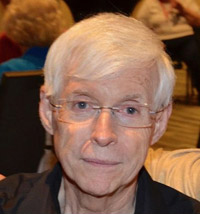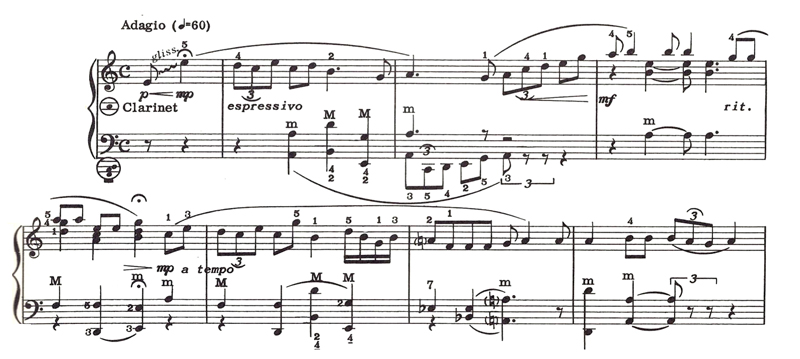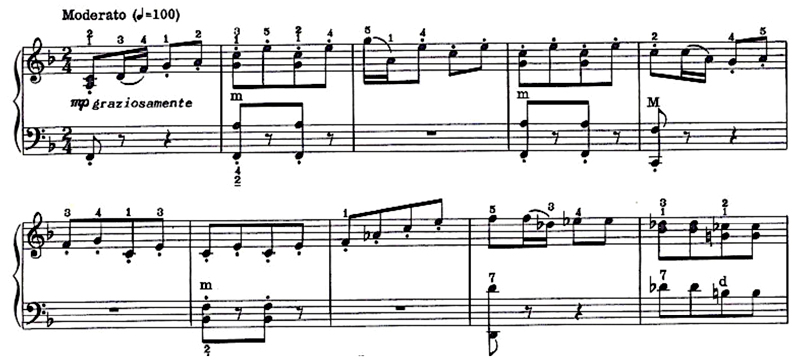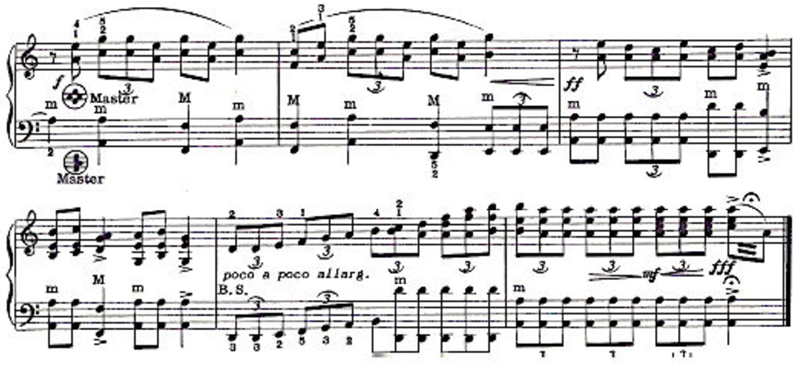Music Commissions Home | Music Commissions Brief History | Music Commissions Articles List | Composer's Guide to the Piano Accordion

As was observed in the previous article of this series (in the 2000 edition of the AAA Festival Journal), the year 1959 rates second only to 1960 as the busiest to date for the AAA Composers Commissioning Committee (CCC). At that time, Chairperson Elsie Bennett managed to persuade five noted composers to accept contracts that resulted in the fourth through eighth commissioned works (in 1960 there were seven such commissions). The first four of these, Virgil Thomson's Lamentations, Carlos Surinach's Pavana and Rondo, Robert Russell Bennett's Four Nocturnes, and Henry Cowell's Iridescent Rondo, were discussed in the two most recent articles, leaving only the last for this installation: Aria, by one of America's most eminent African American composers, William Grant Still.
Through this transaction, Bennett and the Still family became close friends, resulting in a greater amount of correspondence and more publicized writings by Ms. Bennett on both the composer and the work than was common with other AAA commissiionees. Therefore, more information than usual will likewise be imparted here, with concentration on only the one piece and composer.

William Grant Still, visitor Elsie Bennett, and Still’s second wife and collaborator, pianist, librettist, and writer Verna Arvey, at their Los Angeles home, July 27, 1962. Elsie Bennett CCC photo album. |
Born in 1895 to educated and musical parents, Still grew up under very favorable conditions in Little Rock, Arkansas (which, at that time, was a haven of racial tolerance and opportunity in an otherwise Jim Crow region of America). He was exposed to music through his grandmother's casual singing of hymns and spirituals around the house and his stepfather's love of stage music and the arts in general. He ultimately became skilled on the violin, cello, and oboe, matriculated in music at Wilberforce University and Oberlin College, studied composition with George Chadwick and Edgard Varèse, served as an arranger for George C. Handy, Artie Shaw, and Paul Whiteman, among many others, and an orchestrator for radio programs. His love of spirituals and the blues eventually pre-empted his modernist training from Varèse, and his hauntingly romantic music always exuded these qualities. His most famous work is the Afro-American Symphony (1930), but the pinnacle of his career was reached in the premiere of one of his eight operas, Troubled Island, in New York, in 1949.
Still has often been called the "Dean of African-American Composers." This is partly because, as a black American, he experienced many firsts in the history of our country's music: the first to write a major orchestral work which was performed by a major American orchestra, to conduct a major symphony orchestra in the United States as well as in the deep South, to have an opera produced by a major American company, to have an opera televised over a national network (posthumously), and, yes, to write a classical work for accordion.
Elsie Bennett invited Still to do the last sometime in 1959. This proved to be a favorable time to offer the commission to him since he seemed to be in a lull between two very active periods. In 1958, for example, he had completed his third symphony and an opera, Minette Fontaine, among other works, and in 1960 he would produce Patterns and The Peaceful Land, both for orchestra, and his "Lyric" String Quartet. 1959, on the other hand, only saw a discarded piece for orchestra (Legend) and a song cycle (From the Hearts of Women).
Since the Still family was then living in Los Angeles, New York-based Carmen Carrozza, who usually served as an advisor for commissionees, as well as performer for their resulting pieces' premieres, suggested to Ms. Bennett that she ask Myron Floren, who was active at that time in Hollywood on the immensely popular Lawrence Welk television show, to assist Still. Floren agreed to do this and wrote to Ms. Bennett on January 11, 1960, that he had just consulted with the composer. Apparently, Still had already completed the piece before Floren arrived at his home, for the accordionist reported that Still's musician wife, Verna Arvey, "played the Aria on the piano first and then we began working from the beginning and I would play each phrase with different switches until he heard the sound that he had had in mind in writing the piece."

Still and Myron Floren around the time of their meeting at Still’s home, 1262 South Victoria Avenue, Los Angeles. |
Still also wrote to Ms. Bennett about Floren's visit, and enthusiastically sang his praises of the accordion. This Christmas Eve, 1959, letter was partially quoted in an article by Ms. Bennett on the commission in the February 1961 issue of Accordion and Guitar World:
| My association with Mr. Floren made me realize what the instrument can accomplish in the way of virtuosity and in sustained and flowing melodies. One can no longer speak simply of 'the sound' of an accordion, because of the variety of its tonal effects. After hearing some of the striking and appealing things that can be done on it, I would say that it not only has many resources, but it could very well be used with marked effectiveness in the orchestra. I am interested enough to want to again write for the accordion, and I am sure that as other composers listen to and study the instrument carefully, they, too, will share my enthusiasm for it. |
Still did, in fact, write another piece, Lilt, for the AAA several years later, to be discussed in a future installment of this series. In the ensuing years, Aria would serve as the test piece a number of times in AAA competitions. It is also one of the most frequently performed pieces of the commissions, probably owing to both its accessible romantic and expressively melodious, somewhat “bluesy” nature and its reasonable technical demands. Concerning the latter, however, Aria is not as easy as it may first appear on the page. Some tricky finger work may be encountered in the fairly lively middle section of the piece, but it is easily rivaled by the heavy virtuosic requirements of such other AAA commissions as the Creston Concerto and Krenek Toccata. That said, however, the writer has played few pieces that make as high a demand on the performer's expressive instincts and maturity -- and expose performance mistakes so nakedly!
The world premiere of Aria took place on Sunday afternoon, May 15, 1960, at New York’s Town Hall as part of the Sano Accordion Symphony concert. Participating artists were Eugene Ettore, conductor of the accordion orchestra, guest artist Myron Floren, who, as planned, performed Aria as well as Robert Russell Bennett's Four Nocturnes (another AAA commission which was premiered a year before; see previous article in this series), and Judy Procida, who served as narrator for a musical novelty tribute by Ettore (with words by his student Rosemarie Gerber [now Cavanaugh]) to Floren entitled Hey! Myron. The rest of the program consisted of accordion orchestra transcriptions of such works as Moussorgsky's A Night on Bald Mountain, Donizetti's overture to Don Pasquale, and the finale of Tchaikovsky's Fourth Symphony. Francis D. Perkins, of the New York Herald Tribune, gave a favorable review, saying that the two original works (the Still and Bennett pieces) possessed "melodic appeal and variety of mood," and that they "revealed their composers' understanding of the accordion's requirements and resources."
So grateful was the AAA for this delightful little piece that Mr. Still was honored on June 25, 1962, at the Annual AAA Dinner Dance, at the Commodore Hotel in New York. Unable to attend, he sent his good friend, composer Kay Swift (perhaps most acclaimed for her 1930 Broadway hit, Fine and Dandy), to receive a special plaque for him.
Concerning the music itself, in an undated letter from Still to Ms. Bennett that must have been received sometime during early 1960 the composer describes the form of his piece as a rondo that breaks down into the following eight subdivisions:
1. Theme I / 2. Theme II (extended by development) / 3. Theme I / 4. Here a codetta takes the place of a transition / 5. Theme II (strongly contrasted and extended by development) / 6. Retransition / 7. Theme I / 8. Coda.
Years later, in 1968, Still offered another description, this time more general, of Aria in a letter to Bennett. He wrote in the third person so that she could more fluently include it in a future article of hers about him. In this instance, the title is explained as well. (As it turned out, the quotation was never used.)
The composer's love for opera led him to write a broad, soaring melody reminiscent of operatic music. This appears at the beginning and end of Aria, the sections separated by a Scherzo-like movement demanding nimble fingers and a clear sense of rhythm. The piece employs many of the unique resources typical of the accordion as an instrument. Aria may thus be more readily heard as a large A/B/A1 form rather than a rondo. This is because Still's earlier designated items 1 through 4 (comprising the "Broad, soaring melody" to which he refers directly above) seem to be all of one fabric, owing to the slow but rather rubato tempo and a fairly faithful adherence to the Aeolian mode (the unaltered A-minor key, to be further examined below) in the main double period portion of the principal theme:

The melodic line of this theme in its beginning stages strictly follows the Aeolian mode scale, A B C D E F G, which is the same as the A pure minor scale form, and that lacks the usual tonally defining key element of a half step between the seventh and eighth notes (returning first note A at the top of the octave), G to A becoming G-sharp to A. The result is a more ethereal, less imposing melody in which the tonic A is perhaps a bit less powerful.
Still further weakens the tonal focus of his line by often avoiding half-step elements of the scale in general, in this case between B and C or E and F. This temporarily changes the mode to a five-note, or “pentatonic” scale: A B D E G or A C D E G, for example. Note in the excerpt that despite all seven notes of the Aeolian mode appearing in the melody in one place or the other, there is no occurrence anywhere of a direct motion of B up to or down from C, or E up to or down from F, creating yet another softening effect to the theme. (Exceptions will happen later on beyond this part of the piece, however, but not in great quantity.)
This dreamy melodic effect is further enhanced and supported by the gentle, somewhat unstable left-hand chords which, though brought into clarity when needed by the frequent return of the tonic A-minor triad, consists largely of what are often termed in popular music as “major sixth chords,” i. e., major triads with a major 6th added, or what in classical harmony would be regarded as minor seventh chords (minor triad plus minor 7th) in first inversion. Examples in the above excerpt may be seen in the first complete measure, beats 3 and 4, where there is a D-major triad, whose pitches would be D, F-sharp, and A, plus the added B, a major 6th above the root (D) of the chord. The more academically “correct” analysis, however, would be B-minor seven, in first inversion: B-D-F- sharp-A, inverted to D-F-sharp-A-B, from the bottom up.
Similarly, the fourth-beat chord in that measure would be G-B-D-E, though in this instance, the 6th (E) has been put on the bottom, thus creating an E-minor 7th chord (E-G-B-D) whose power is strengthened by its root (E) being in the very audibly lowest (“bass”) voice. This gives it the all important tonal function of the “dominant” chord, built on the fifth scale degree and always important to frequently occur just prior to the first, or “tonic,” harmony of the scale (or “mode” in this case) of the composition. Nevertheless, the effect of any such combination of notes and intervals will create the same soft and gentle “bluesy” effect. This is characteristic of Still’s style in all of his compositions, though in other parts of Aria and all of his works in general, he will freely add chromatic notes when he feels so inclined, brief changes from major to parallel minor keys, and other musical freedoms most composers are inclined to employ where they seem to work well expressively.
Despite such commonplace liberties, however, Still was not one to indulge in complicated rhythm, irregularity of phrasing, or sharply dissonant harmony beyond what was common in the freely applied but milder and mostly diatonic “added-third” structures that so often permeate jazz textures, such as 7th, 9th,11th, and 13th chords.
Item 5 (the "Scherzo-like movement" mentioned in Still’s second quotation above) is in a sprightly, faster tempo, and a considerably chromaticized but clear F-major key, and presents a strong contrast to what came before despite its disguised derivation from the earlier "Theme II":

And, following the section 6 blues-like, slow retransition, a truncated, but nonetheless lengthy, return of the opening section's main theme and, very importantly, slow tempo and A-minor tonality, prior to the dramatic coda displayed here:

The "unique resources typical of the accordion" which Still employs are modest, but effectively idiomatic. These include tasteful uses of the "clarinet," "oboe," and "musette" right-hand switches in particular, a brief three-measure employment of bellows shake at the end of the "Scherzo" that serves as a transition into the returning and somewhat altered opening theme, and most importantly, a highly expressive, singing, violinistic melodic line, especially in the outlying slow sections, dependent on sensitive bellows-controlled nuances possible only on the accordion among the keyboard instruments.
The mood of the entire work is very peaceful and poetically fragile, with characteristically Stillian touches of modal, pentatonic, and quartel writing moderately imposed upon an otherwise frankly tonal and post-romantic style.
There is also a melancholy, and almost resigned and tragic, quality to the music. Still was a gentle and kind man by nature, and his music often had this quiet, understated, but highly expressive quality. However, it can have surprising, but very natural, outbreaks of intense emotion at times, as happens in the coda of Aria. But there may be another reason for Aria's bittersweet quality. Still's daughter, Judith Anne Headlee, long-time promoter of her father's music and head of William Grant Still Music commented in a 1995 letter to the writer that in the 1960s her father was "tired, discouraged and less optimistic, so that his music had a wistful, lyrical quality."
It has been well documented that the discouragement he experienced was that of being somewhat disregarded in the post-World War II world of contemporary music because he was not writing in the then fashionable and more dissonant, expressionistic atonal style in which he briefly dabbled but soon abandoned decades earlier after having studied with Varèse.

Anne McMahan, Pietro “Lee” Deiro, Jr., Elsie Bennett, Judith Anne Still, and Robert McMahan, Caravelle Restaurant, Brooklyn, NewYork, November 5,1995, following a concert by the Brooklyn Philharmonic Orchestra at the Brooklyn Academy of Music, entitled From Gospel to Gershwin, which included music by Still; conducted by Gunther Schuller and hosted by Judith Still, who gave a pre-concert talk and participated in a panel discussion onstage after the concert. Elsie Bennett AAA photo album. |
In fact, many of the more post-romantic or "neoclassical" composers who had thrived during the first half of the century, and who often accepted commissions from the AAA late in life, were going through similarly lonely periods in their careers. Happily, though, a more balanced view of works in various styles lasting into or emerging from the second half of the Twentieth Century is being taken from the safe distance of the fledgling new millennium so that the less radical music of the previous decades is beginning to receive more serious attention.
Accordingly, by the time of Still's one hundredth anniversary festival, in 1995, at the University of Arkansas, where most of his papers are preserved, and where the writer was invited to give a performance/lecture on the two accordion pieces, his music was already beginning to enjoy a posthumous revival. Soon thereafter, one could find specially marked bins of his music in most record shops and large bookstore chains. This is more than one can say about many other deserving American contemporary composers, living or dead, “radical” or “accessible;” but few have had as dedicated a devotee to their legacy, both intellectually and commercially, as Still’s daughter, Judith Anne. She established the aforementioned William Grant Still Music company (see http://www.williamgrantstillmusic.com/) after her father’s death and has tirelessly promoted and protected his music ever since. Her daughter, Celeste Headlee (named after the principal role in Still’s opera Troubled Island) has brought further distinction to the family as a highly respected radio journalist, author, and co-host of the weekly series Retro Report on the Public Broadcasting System (PBS). (See her touching remembrance of her famous grandfather at https://celesteheadlee.com/happy-birthday-william-grant-still/ .)
With his largely American-based subject matter (such as the blues, spirituals, African-American issues and poetry, etc.), Still stands, in this writer's view, with other great American composers, such as Aaron Copland and Charles Ives, whose most popular and enduring works were inspired by and drawn from their shared country’s diverse cultures and history. In addition, no textbook on American music or general music history with a chapter devoted to America’s music would think of excluding Still from its pages any more than it would Copland or Ives. Still is there to stay, in large part because of his Americanism and, of course, his perspective as an African American.
Returning to matters concerning the accordion, a further benefit of the resurgence of Still’s popularity is that it bodes well for many of the past AAA commissioned works by other major American figures of his generation whose resulting and unique contributions to the accordion’s concert repertoire were not taken very seriously during the last third of the twentieth century in academic music circles because their modes of composition were then considered out of fashion and built on earlier, allegedly passé twentieth century techniques. Happily, however, the passage of time has been gradually eroding such unfortunate and overly doctrinaire notions in the professional realm and is allowing greater fairness in evaluating all music of that wonderfully diverse and explosive era in music.
All this said, Aria and Still's later accordion solo, Lilt, are little masterpieces for accordion that obviously reflect the composer's very best effort to not only produce excellent music in his highly personalized style, but to write imaginatively and idiomatically for the accordion as well. They would be most definitely at home and welcomed on any professional program of twentieth century American works; but students at the intermediate or early advanced levels who are looking for a challenge in musical expression and a gentle introduction to the wonderfully varied world of twentieth century concert music should also give them a try. There is much to learn-- and enjoy--from them.
Dr. McMahan performed and discussed Aria along with other works, in his workshop, “The Accordion and Contemporary Music,” during the 2001 AAA Festival. His performances of Aria may be heard on the AAA Commissioned Works listing (https://www.ameraccord.com/aaacommissions.php) and in concert on Youtube at https://www.youtube.com/watch?v=wFzUBtG4EJQ.
For a fuller account of Aria, as well as similar examinations of Lilt and the only other known serious work for accordion by an African-American composer, Ronald Roxbury, see McMahan's article "Serious Works for Accordion by African-American Composers: Aria and Lilt by William Grant Still, and Four Preludes, by Ronald Roxbury," in Free Reed Journal, Vol. 1, 1999 (Pendragon Press; published by the Center for Study of Free-Reed Instruments, Graduate Center of the City University of New York, Prof. Allan Atlas, Curator and Editor of the journal). This article may be directly accessed on the Composers Commissioning Committee articles section of the AAA website at https://www.ameraccord.com/commissions/african-american.htm
Also see McMahan’s article “The Accordion Works of William Grant Still” at
https://free-reed.net/essays/mcmahan.html
and
https://africlassical.blogspot.com/2011/05/william-grant-stills-aria-for-accordion.html
https://africlassical.blogspot.com/2011/05/mcmahans-performance-combined.html
Three AAA commissioned works were performed by Drs. McMahan and William Schimmel at the 2001 AAA Accordion Master Class and Concert Series, July 27-29: Curriculum Vitae, by Lukas Foss, Salute to Juan, by Paul Pisk, and Partita, by Alexander Tcherepnin.
The AAA Composers' Commissioning Committee welcomes donations from all those who love the classical accordion and wish to see its modern original concert repertoire continue to grow. The American Accordionists' Association is a 501(c)(3) corporation. All contributions are tax deductible to the extent of the law. They can easily be made by visiting the AAA Store at https://www.ameraccord.com/cart.aspx which allows you to both make your donation and receive your tax deductible receipt on the spot.
For additional information, please contact Dr. McMahan at grillmyr@gmail.com
2026 AAA 88th Anniversary Festival Daily ReportsAugust 13-16, 2026 Latest NewsMario Tacca, Mary Mancini AAA fundraiser. 2026 AAA Elsie M. Bennett Composition Competition 2025 AAA Elsie M. Bennett Composition Competition Results AAA History ArticlesHistorical Articles about the AAA by AAA Historian Joan Grauman Morse Music CommissionsHistorical and analytical articles by Robert Young McMahan. Recent articles:
AAA NewslettersLatest newsletters are now online. |